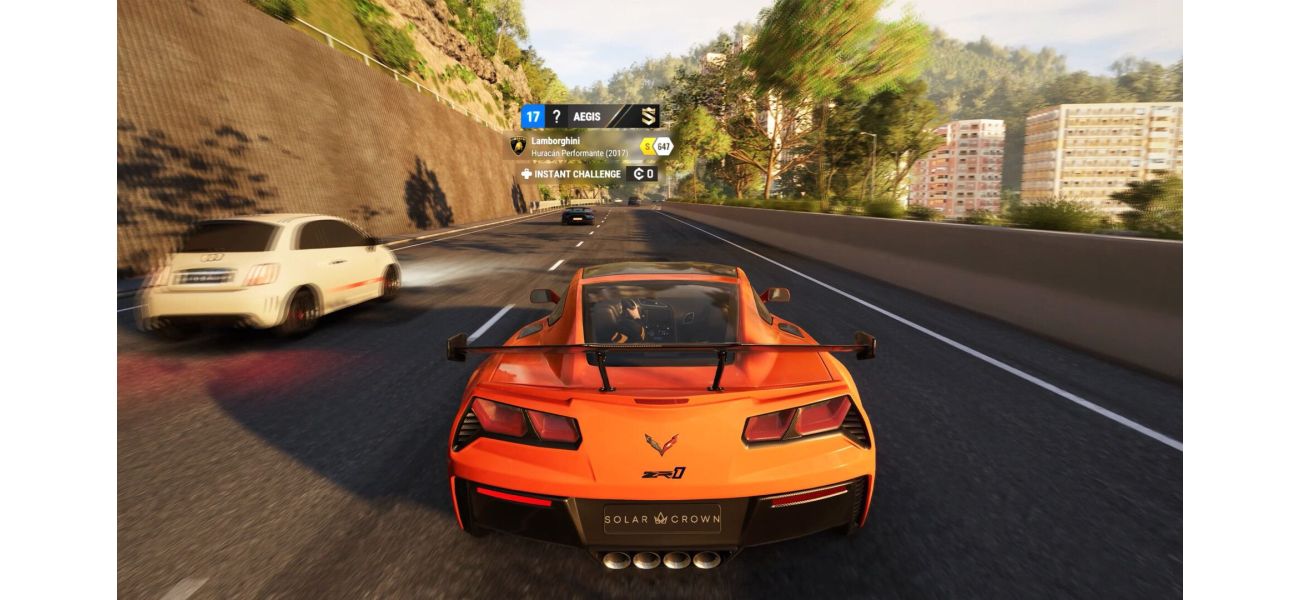Review of Test Drive Unlimited Solar Crown: chaotic coronation experience.
"Long-awaited Test Drive Unlimited 3 is here, but Solar Crown event faces early obstacles."
September 12th 2024.

After much anticipation, the third installment of the Test Drive Unlimited series, Solar Crown, has finally been released. However, the highly anticipated racing event is not off to a smooth start. The original Test Drive game was released in 1987 and while it was a hit at the time, it was also an early attempt at 3D graphics which resulted in a somewhat wobbly appearance. Despite this, it spawned multiple sequels over the years. It wasn't until 2006 that the franchise expanded into an open world game, with its setting being a recreation of the Hawaiian island of Oahu. This was when Test Drive Unlimited was born.
The game was followed by a single sequel in 2011, but since then, the Unlimited series has been lying dormant. That is, until now. Solar Crown is a brand new open-world driving game, set on Hong Kong Island. It's worth noting that this is not the Hong Kong that is famous for its towering skyscrapers, but rather a more rustic island situated next to it. The island offers a diverse range of roads, from A-roads and motorways to winding country roads and dirt tracks, making it the perfect location for a racing game that caters to different driving styles. This is exactly what Solar Crown aims to do. Don't be fooled by its name though, as it may sound like a type of weatherproof house paint, but in the world of Test Drive, Solar Crown is a renowned street racing event.
Similar to its predecessors, Solar Crown is marketed as a massively open online racing game, essentially a driving MMO. The game starts off with you customizing your avatar, who to be honest, looks a little less than appealing. Once your avatar is ready, you are placed in the Solar Crown Hotel, which acts as the hub for all of the island's competitive events. Instead of starting behind the wheel, you are encouraged to pick an outfit and then make your way to the lobby and eventually the garage to select your car. However, one of the game's frustrating design choices is that every time you start the game, you are forced to go through this entire process, which can be quite tedious.
The same process applies when purchasing and upgrading cars. Instead of simply using a menu, you have to physically walk around various showrooms in a first-person view, approaching each car to check its stats, price, and reputation level required to buy it. It's a time-consuming and unnecessary feature that seems to have been intentionally designed to test your patience.
What adds to the strangeness of this decision is that, unlike most characters in the game, your driver is completely mute. This means that during cutscenes, your avatar remains silent, while other characters try to engage in conversation. It can make for some awkward interactions, with your avatar simply nodding along in silence when asked a question.
To unlock each race event, showroom, and workshop, you have to physically drive to it in real-time, which does make sense in terms of rewarding players for exploring the expansive island. It can be quite enjoyable to drive around the island, admiring the scenery, but the game's fast travel system suggests that the developers are aware that this may become tedious after a while. This also brings attention to some of the game's other issues.
One of the main problems is the game's outdated graphics. The draw distance is limited, and the traffic on the roads looks like it was taken from a PlayStation 3 game. There is also a strange glitch where cars seem to disappear suddenly in front of you. On the bright side, many objects on the roadside can be destroyed, adding a touch of realism to the game.
The game's handling model is fairly simple and arcade-like by default. However, turning off the driving aids can make a noticeable difference, making races more challenging and rewarding. This may be a trade-off for some, as it also increases the difficulty level of the AI opponents. Despite this, having a more realistic physics model makes for a more enjoyable driving experience.
Solar Crown is an always online game, meaning that most of the time, you will be racing against real players rather than AI. However, this feature has caused some issues during the review period, with server outages, maintenance periods, and races that won't start as intended. While these glitches have been reduced with the game's official release, it may not be much consolation for those who paid a hefty price for the early access Gold Edition. Reports suggest that PC players had a smoother experience compared to console players.
When the game is working as intended, Solar Crown has some interesting features, such as its unique meta game. After leveling up at the beginning of the game, you are recruited to join one of two rival clans. Certain race events help to increase your clan's influence, adding an extra layer of motivation to your gameplay. The game also puts less emphasis on constantly switching cars, as new cars and upgrades are only unlocked at higher reputation levels. This forces players to become more familiar with their first car, while also saving up for future purchases.
The slow pace of unlocking new features may be due to the game's initial release only offering 99 cars, which may seem like a lot, but is significantly less compared to other racing games like Gran Turismo 7 and Forza Horizon 5, which have expanded their rosters since their releases. There are also some minor issues that suggest the game may have been rushed to market, such as the brightness and contrast settings rendering the side and rearview mirrors unusable, and the fact that they are only visible in certain camera views.
In conclusion, while Solar Crown may have its fair share of problems, it still offers some unique and interesting features for racing game fans. The game's meta game and focus on personal progress rather than constantly swapping cars sets it apart from its competitors. However, it may have been released before it was fully polished, with outdated graphics and some frustrating design choices. With that said, it's still worth giving Solar Crown a test drive, but perhaps not worth the long wait.
After much anticipation, the third installment of the Test Drive Unlimited series, Solar Crown, has finally been released. However, the highly anticipated racing event is not off to the smooth start that fans were hoping for.
It all began back in 1987 with the release of the original Test Drive game. While it was an early attempt at 3D graphics, it was a huge hit and spawned multiple sequels over the years. It wasn't until 2006 that the franchise took a leap into the open-world genre, with a virtual recreation of the Hawaiian island of Oahu, and thus Test Drive Unlimited was born.
There was only one sequel to this open-world racing game, released in 2011, and since then the Unlimited series has been dormant. That is, until now. Solar Crown, the latest addition to the franchise, takes players to a new location - Hong Kong Island. But it's worth noting that this isn't the bustling, skyscraper-filled Hong Kong that we often see in movies and TV shows. Instead, it's a more rustic and less urban island adjacent to the main city.
With a mix of A-roads, motorways, country roads, and dirt tracks, Hong Kong Island offers a diverse and challenging landscape for a racing game. And that's exactly what Solar Crown aims to deliver. For those unfamiliar with the game's premise, it's important to know that Solar Crown is not just a fancy name for a racing event, but rather a renowned street racing competition within the world of Test Drive.
Similar to its predecessors, Solar Crown is a massively open online racing game, almost like a driving MMO. Players start by customizing their avatar, which, to be honest, can be quite dreadful-looking. Then, they are situated in the Solar Crown Hotel, which serves as the central hub for all of the island's competitive events.
But here's where things get a little tedious - instead of starting behind the wheel, players are encouraged to choose an outfit before heading down to the hotel lobby, and then finally making their way to the garage to select a car. And to make matters worse, every time the game is started, players are forced to go through this pointless routine, which can become quite frustrating.
The same process applies when purchasing and upgrading cars. Instead of a simple menu, players have to navigate through an anodyne and architecturally identical showroom in first person, approaching each vehicle to learn its stats, price, and the required reputation points needed to unlock it. It's a design choice that seems to intentionally waste the player's time and patience.
Adding to the oddness of this decision is the fact that the player's driver is completely mute, like the character Link from The Legend of Zelda. This makes one-sided conversations in cutscenes feel quite awkward, with the avatar gesturing but never saying a word. For example, when asked about their thoughts on a dealership, the only response from the avatar is a polite nod.
To unlock each race event, showroom, and workshop, players must physically drive to them in real-time, allowing them to discover and explore the island's expansive geography. While this can be enjoyable at first, the game's comprehensive fast travel system suggests that the developers knew players would tire of this feature quickly. And this brings us to some of the game's other issues.
One of the most noticeable problems is the game's last-gen graphics. The draw distance is limited, the traffic on the roads looks like it was taken from a PlayStation 3 game, and cars have a habit of disappearing in front of the player. On the bright side, most of the street furniture can be destroyed, similar to Forza Horizon, allowing players to crash through railings and bus shelters that have been inconveniently placed.
As for the gameplay, the default handling setting is fairly simple and arcade-like. While taking the racing line is still beneficial, cars can feel quite similar, except for when driving in the rain or with a rear-wheel drive car. However, turning off some of the driving aids can make the physics model feel more subtle, making races more challenging and rewarding.
One major aspect of Solar Crown is its online component, where players will mostly be racing against real human drivers instead of AI. While this may sound exciting, it has its fair share of problems. During the review period, there were frequent server outages, lengthy maintenance periods, and races that wouldn't start as intended. And even though these issues have lessened as the game's launch day approaches, it's little consolation for players who paid extra for early access through the Gold Edition. Reports from online players suggest that PC players had a smoother experience than console players.
When everything is functioning properly, Solar Crown has its fair share of flaws, but it does offer some interesting features. Its meta-game, in particular, stands out and differentiates itself from other racing games. Players are recruited into one of two rival clans, and certain race events contribute to their clan's influence, adding an extra layer of motivation to their gameplay.
Another unique aspect of Solar Crown is its lesser emphasis on constantly switching cars. Players begin with one of three starter cars, which can be upgraded with base level modifications. However, the next tier of cars and upgrades is only available once the player reaches a higher reputation level. This means that players will have to spend some time getting to know their car before being able to buy a new one, which can be a refreshing change of pace.
It's worth noting that at launch, Solar Crown includes a selection of 99 cars, which may seem like a lot, but it pales in comparison to other racing games such as Gran Turismo 7 and Forza Horizon 5, which have over 400 and 500 cars, respectively. Additionally, both of these games have added numerous new cars since their initial releases.
Many of the game's other issues seem to be small annoyances rather than game-breaking bugs, which could suggest that Solar Crown was rushed to market. For example, following the game's recommended brightness and contrast settings makes the side and rearview mirrors unusably dark, and even when they are visible, they can only be seen in two of the game's multiple camera views. Instead, little arrows appear behind the player's car when an opponent is close behind, making it difficult to drive defensively when in the lead.
The game was followed by a single sequel in 2011, but since then, the Unlimited series has been lying dormant. That is, until now. Solar Crown is a brand new open-world driving game, set on Hong Kong Island. It's worth noting that this is not the Hong Kong that is famous for its towering skyscrapers, but rather a more rustic island situated next to it. The island offers a diverse range of roads, from A-roads and motorways to winding country roads and dirt tracks, making it the perfect location for a racing game that caters to different driving styles. This is exactly what Solar Crown aims to do. Don't be fooled by its name though, as it may sound like a type of weatherproof house paint, but in the world of Test Drive, Solar Crown is a renowned street racing event.
Similar to its predecessors, Solar Crown is marketed as a massively open online racing game, essentially a driving MMO. The game starts off with you customizing your avatar, who to be honest, looks a little less than appealing. Once your avatar is ready, you are placed in the Solar Crown Hotel, which acts as the hub for all of the island's competitive events. Instead of starting behind the wheel, you are encouraged to pick an outfit and then make your way to the lobby and eventually the garage to select your car. However, one of the game's frustrating design choices is that every time you start the game, you are forced to go through this entire process, which can be quite tedious.
The same process applies when purchasing and upgrading cars. Instead of simply using a menu, you have to physically walk around various showrooms in a first-person view, approaching each car to check its stats, price, and reputation level required to buy it. It's a time-consuming and unnecessary feature that seems to have been intentionally designed to test your patience.
What adds to the strangeness of this decision is that, unlike most characters in the game, your driver is completely mute. This means that during cutscenes, your avatar remains silent, while other characters try to engage in conversation. It can make for some awkward interactions, with your avatar simply nodding along in silence when asked a question.
To unlock each race event, showroom, and workshop, you have to physically drive to it in real-time, which does make sense in terms of rewarding players for exploring the expansive island. It can be quite enjoyable to drive around the island, admiring the scenery, but the game's fast travel system suggests that the developers are aware that this may become tedious after a while. This also brings attention to some of the game's other issues.
One of the main problems is the game's outdated graphics. The draw distance is limited, and the traffic on the roads looks like it was taken from a PlayStation 3 game. There is also a strange glitch where cars seem to disappear suddenly in front of you. On the bright side, many objects on the roadside can be destroyed, adding a touch of realism to the game.
The game's handling model is fairly simple and arcade-like by default. However, turning off the driving aids can make a noticeable difference, making races more challenging and rewarding. This may be a trade-off for some, as it also increases the difficulty level of the AI opponents. Despite this, having a more realistic physics model makes for a more enjoyable driving experience.
Solar Crown is an always online game, meaning that most of the time, you will be racing against real players rather than AI. However, this feature has caused some issues during the review period, with server outages, maintenance periods, and races that won't start as intended. While these glitches have been reduced with the game's official release, it may not be much consolation for those who paid a hefty price for the early access Gold Edition. Reports suggest that PC players had a smoother experience compared to console players.
When the game is working as intended, Solar Crown has some interesting features, such as its unique meta game. After leveling up at the beginning of the game, you are recruited to join one of two rival clans. Certain race events help to increase your clan's influence, adding an extra layer of motivation to your gameplay. The game also puts less emphasis on constantly switching cars, as new cars and upgrades are only unlocked at higher reputation levels. This forces players to become more familiar with their first car, while also saving up for future purchases.
The slow pace of unlocking new features may be due to the game's initial release only offering 99 cars, which may seem like a lot, but is significantly less compared to other racing games like Gran Turismo 7 and Forza Horizon 5, which have expanded their rosters since their releases. There are also some minor issues that suggest the game may have been rushed to market, such as the brightness and contrast settings rendering the side and rearview mirrors unusable, and the fact that they are only visible in certain camera views.
In conclusion, while Solar Crown may have its fair share of problems, it still offers some unique and interesting features for racing game fans. The game's meta game and focus on personal progress rather than constantly swapping cars sets it apart from its competitors. However, it may have been released before it was fully polished, with outdated graphics and some frustrating design choices. With that said, it's still worth giving Solar Crown a test drive, but perhaps not worth the long wait.
After much anticipation, the third installment of the Test Drive Unlimited series, Solar Crown, has finally been released. However, the highly anticipated racing event is not off to the smooth start that fans were hoping for.
It all began back in 1987 with the release of the original Test Drive game. While it was an early attempt at 3D graphics, it was a huge hit and spawned multiple sequels over the years. It wasn't until 2006 that the franchise took a leap into the open-world genre, with a virtual recreation of the Hawaiian island of Oahu, and thus Test Drive Unlimited was born.
There was only one sequel to this open-world racing game, released in 2011, and since then the Unlimited series has been dormant. That is, until now. Solar Crown, the latest addition to the franchise, takes players to a new location - Hong Kong Island. But it's worth noting that this isn't the bustling, skyscraper-filled Hong Kong that we often see in movies and TV shows. Instead, it's a more rustic and less urban island adjacent to the main city.
With a mix of A-roads, motorways, country roads, and dirt tracks, Hong Kong Island offers a diverse and challenging landscape for a racing game. And that's exactly what Solar Crown aims to deliver. For those unfamiliar with the game's premise, it's important to know that Solar Crown is not just a fancy name for a racing event, but rather a renowned street racing competition within the world of Test Drive.
Similar to its predecessors, Solar Crown is a massively open online racing game, almost like a driving MMO. Players start by customizing their avatar, which, to be honest, can be quite dreadful-looking. Then, they are situated in the Solar Crown Hotel, which serves as the central hub for all of the island's competitive events.
But here's where things get a little tedious - instead of starting behind the wheel, players are encouraged to choose an outfit before heading down to the hotel lobby, and then finally making their way to the garage to select a car. And to make matters worse, every time the game is started, players are forced to go through this pointless routine, which can become quite frustrating.
The same process applies when purchasing and upgrading cars. Instead of a simple menu, players have to navigate through an anodyne and architecturally identical showroom in first person, approaching each vehicle to learn its stats, price, and the required reputation points needed to unlock it. It's a design choice that seems to intentionally waste the player's time and patience.
Adding to the oddness of this decision is the fact that the player's driver is completely mute, like the character Link from The Legend of Zelda. This makes one-sided conversations in cutscenes feel quite awkward, with the avatar gesturing but never saying a word. For example, when asked about their thoughts on a dealership, the only response from the avatar is a polite nod.
To unlock each race event, showroom, and workshop, players must physically drive to them in real-time, allowing them to discover and explore the island's expansive geography. While this can be enjoyable at first, the game's comprehensive fast travel system suggests that the developers knew players would tire of this feature quickly. And this brings us to some of the game's other issues.
One of the most noticeable problems is the game's last-gen graphics. The draw distance is limited, the traffic on the roads looks like it was taken from a PlayStation 3 game, and cars have a habit of disappearing in front of the player. On the bright side, most of the street furniture can be destroyed, similar to Forza Horizon, allowing players to crash through railings and bus shelters that have been inconveniently placed.
As for the gameplay, the default handling setting is fairly simple and arcade-like. While taking the racing line is still beneficial, cars can feel quite similar, except for when driving in the rain or with a rear-wheel drive car. However, turning off some of the driving aids can make the physics model feel more subtle, making races more challenging and rewarding.
One major aspect of Solar Crown is its online component, where players will mostly be racing against real human drivers instead of AI. While this may sound exciting, it has its fair share of problems. During the review period, there were frequent server outages, lengthy maintenance periods, and races that wouldn't start as intended. And even though these issues have lessened as the game's launch day approaches, it's little consolation for players who paid extra for early access through the Gold Edition. Reports from online players suggest that PC players had a smoother experience than console players.
When everything is functioning properly, Solar Crown has its fair share of flaws, but it does offer some interesting features. Its meta-game, in particular, stands out and differentiates itself from other racing games. Players are recruited into one of two rival clans, and certain race events contribute to their clan's influence, adding an extra layer of motivation to their gameplay.
Another unique aspect of Solar Crown is its lesser emphasis on constantly switching cars. Players begin with one of three starter cars, which can be upgraded with base level modifications. However, the next tier of cars and upgrades is only available once the player reaches a higher reputation level. This means that players will have to spend some time getting to know their car before being able to buy a new one, which can be a refreshing change of pace.
It's worth noting that at launch, Solar Crown includes a selection of 99 cars, which may seem like a lot, but it pales in comparison to other racing games such as Gran Turismo 7 and Forza Horizon 5, which have over 400 and 500 cars, respectively. Additionally, both of these games have added numerous new cars since their initial releases.
Many of the game's other issues seem to be small annoyances rather than game-breaking bugs, which could suggest that Solar Crown was rushed to market. For example, following the game's recommended brightness and contrast settings makes the side and rearview mirrors unusably dark, and even when they are visible, they can only be seen in two of the game's multiple camera views. Instead, little arrows appear behind the player's car when an opponent is close behind, making it difficult to drive defensively when in the lead.
[This article has been trending online recently and has been generated with AI. Your feed is customized.]
[Generative AI is experimental.]
0
0
Submit Comment





